Llano in the Wild: Toshiba's Satellite L775D-S7206
by Dustin Sklavos on August 12, 2011 12:45 AM ESTBringing Gaming to the Masses
Where I honestly believe Llano shines is in its ability to bring a usable CPU and solid if unspectacular gaming performance south of the $600 price point. Similar configurations to this 17" Toshiba Satellite L775D-S7206 can be had for around $549 or less if you don't mind going down to a smaller, more portable form factor; Toshiba even offers a 14" notebook with the same APU and 4GB of RAM for just that price.
Low Detail Gaming
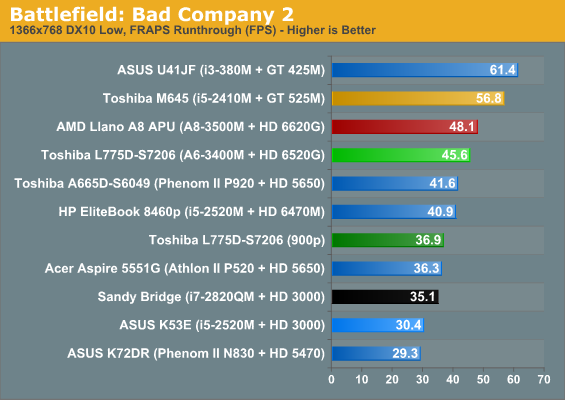
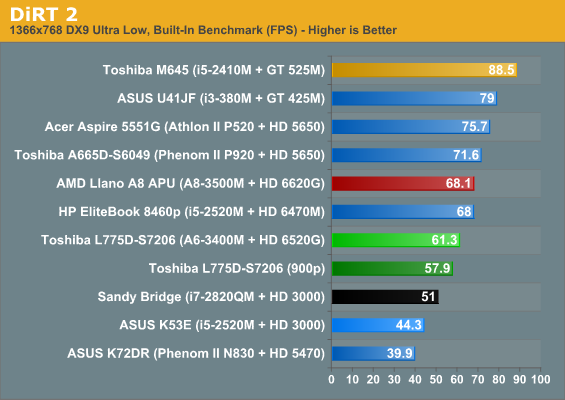
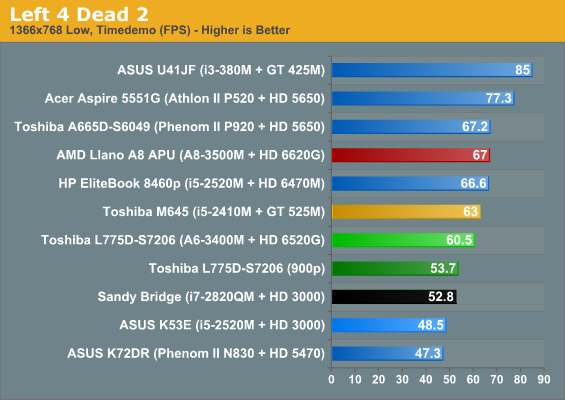
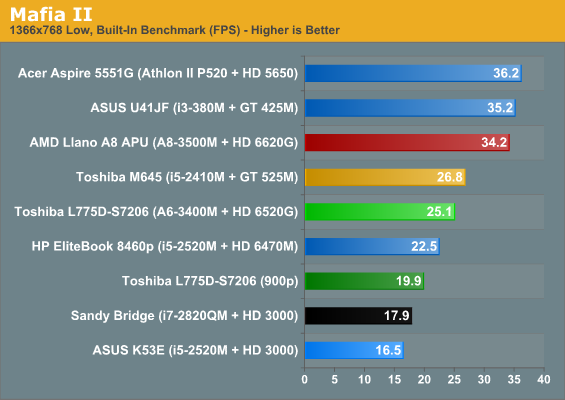
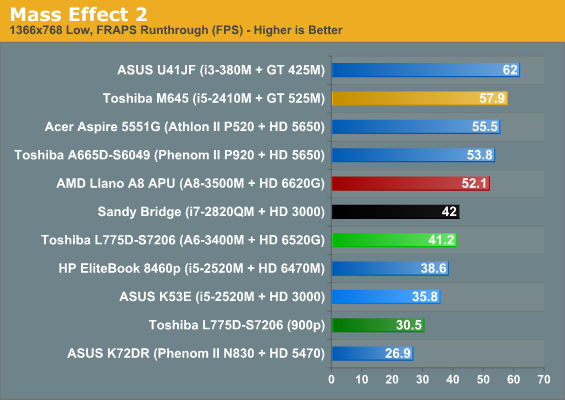
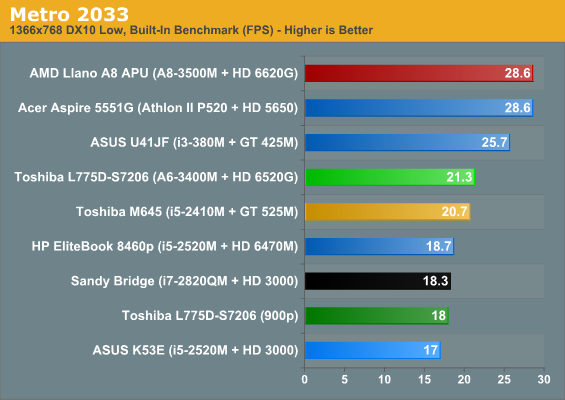
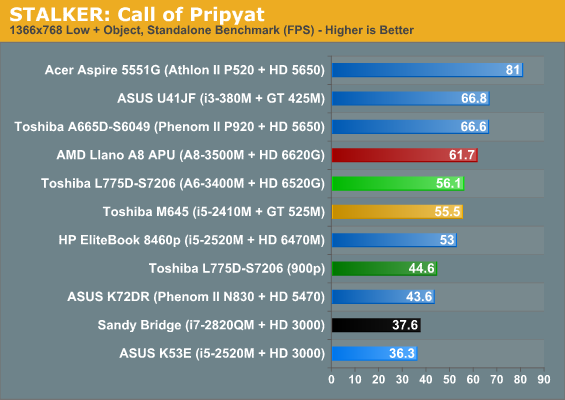
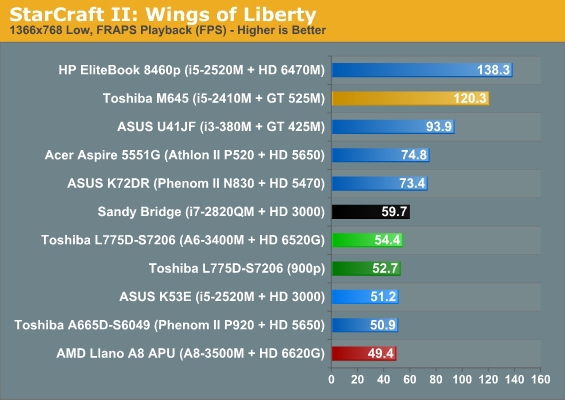
While Mafia II and Metro 2033 continue to punish most any notebook that dares to try and run them, and StarCraft II remains staggeringly poorly threaded and CPU limited, the A6-3400M and its Radeon HD 6520G graphics hardware are able to provide playable gaming experiences in almost every case, oftentimes even at the notebook's native 1600x900 resolution. It isn't ideal, but it's a big improvement over even Sandy Bridge's IGP, although the loss of four TMUs and 80 shaders going from the A8 to the A6 is definitely felt. Interesting to note is that the 6520G in the A6 typically handles 900p slightly better than Intel's HD 3000 handles 768p.
Medium Detail Gaming
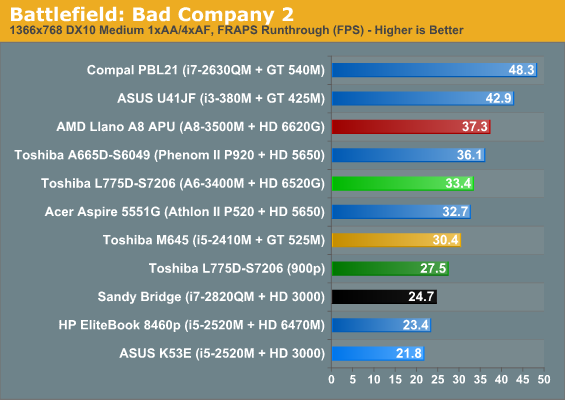
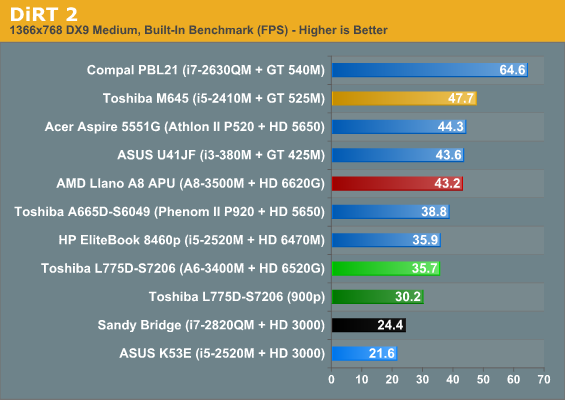
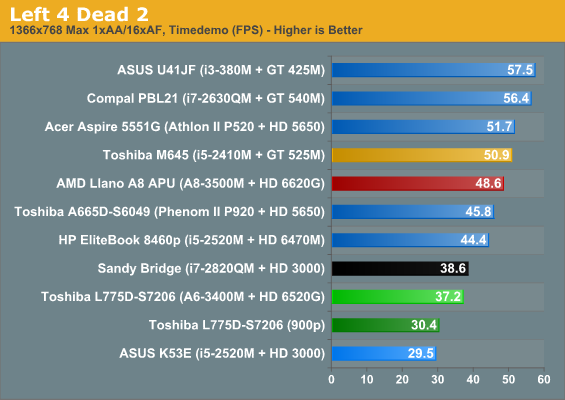
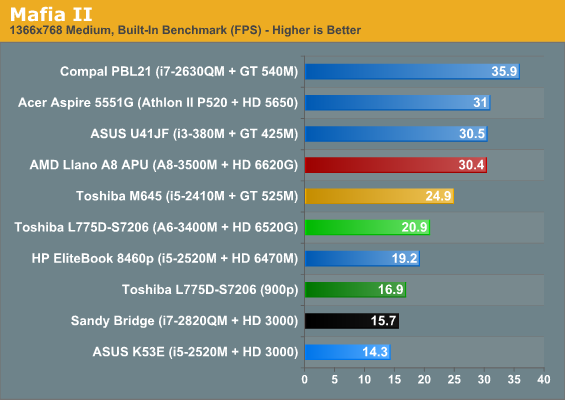
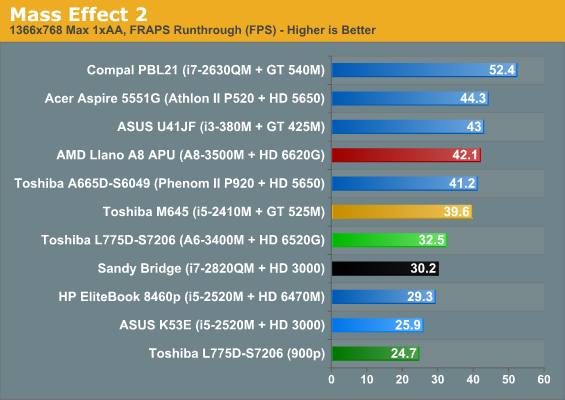
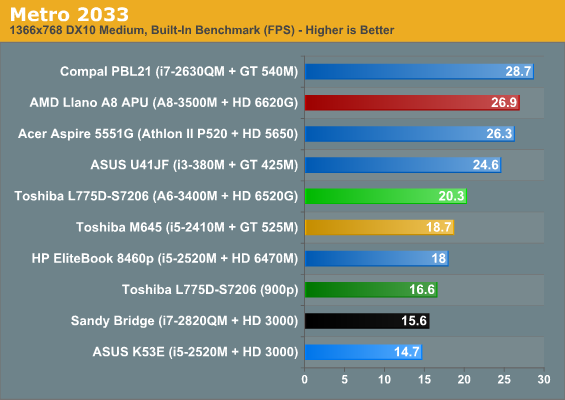
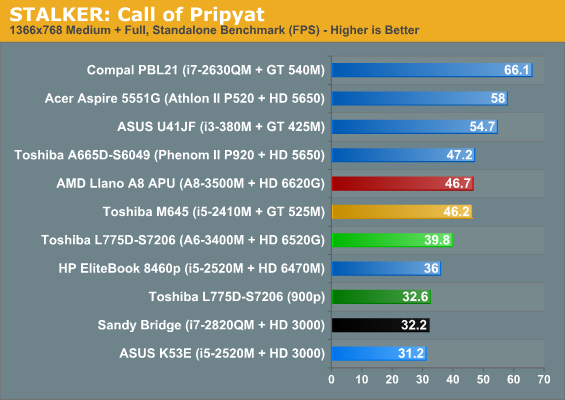
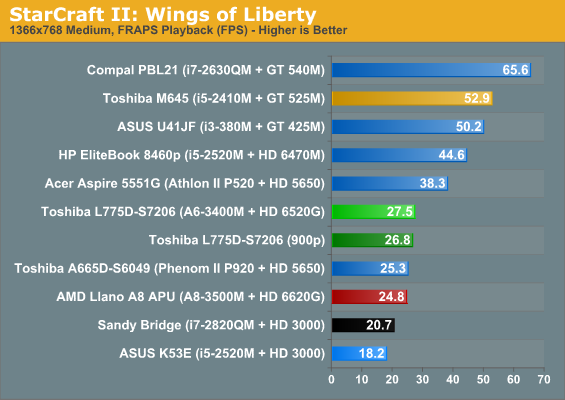
Llano continues to put in a reasonably strong showing at medium settings, though the relative weakness of the four slow Stars cores is felt here. Much like with Brazos, it seems like AMD has crammed just a little too much GPU into these chips, more than the CPU halves can handle. Still, if you want to game on the cheap, the A6 can largely make it happen, with even 1600x900 gaming not entirely out of its reach in some instances. At our Medium settings, Intel's IGP also starts to fall off quite a bit, with very few titles in our suite managing to break 30FPS.
High Quality Gaming
Just for the heck of it, I figured I'd punish the A6-3400M all the way by running our suite of gaming benchmarks at our "high" preset.
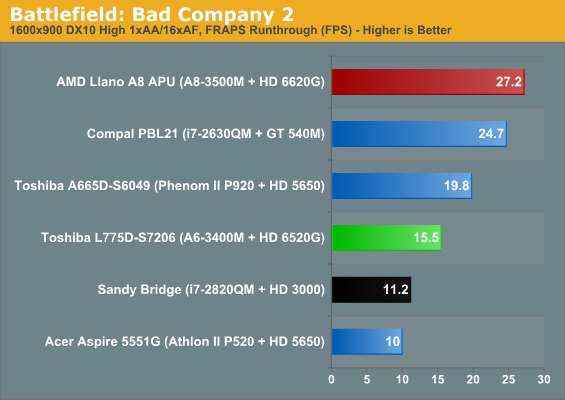

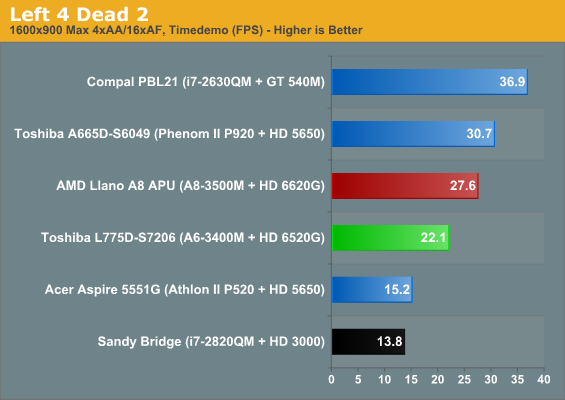
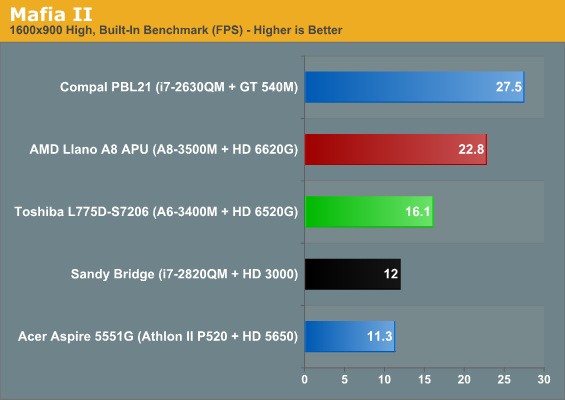
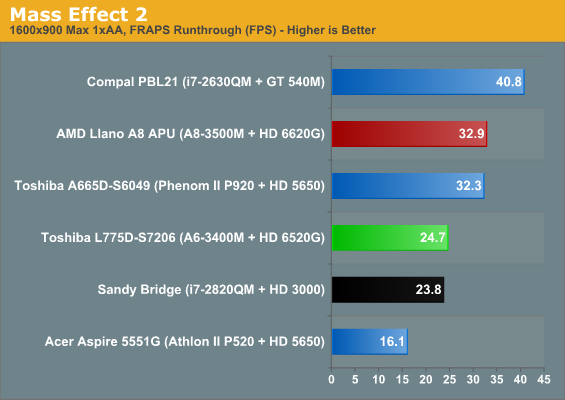
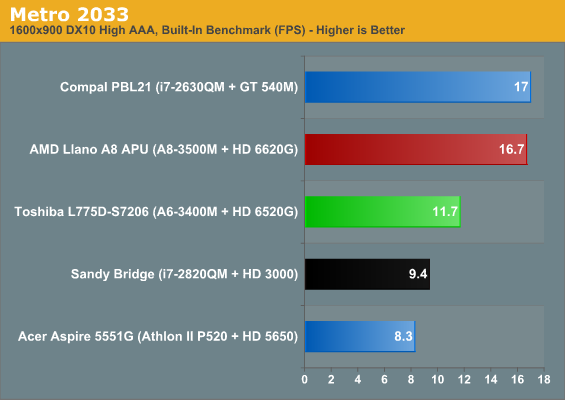

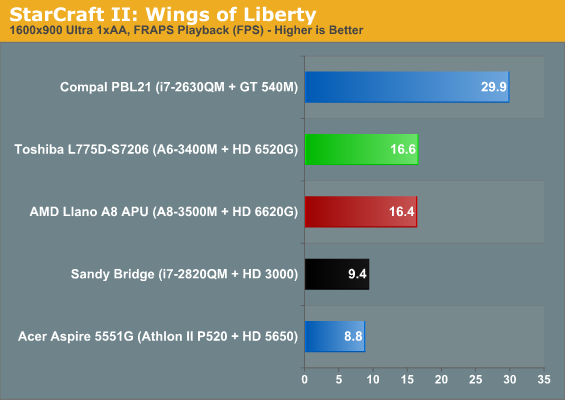
900p proves largely to be too much for this class of graphics hardware; even NVIDIA's dedicated GeForce GT 540M struggles with it. Still, the results are notable and not wholly academic: Llano brings integrated graphics essentially on par with low-to-mid-end dedicated graphics hardware, and that's an achievement. The A6 takes a definite hit compared to the A8 in the GPU, but it still grossly outclasses Intel's HD 3000.










74 Comments
View All Comments
alxnet - Friday, August 12, 2011 - link
There's a number of 30% off or $300 off coupons floating around which gets you a substantial discount off a minimum $1000 custom laptop purchase from HP. Just google HP-30%-Coupon. Got my 9cell dv6z with an A8-3500 and a 1920x1080 screen for under $800. I've got a OEM Vertex 3 240GB which I got for less than $400 after rebate. Combined, it's one hell-uv-a laptop. Eight hours of runtime on average and it boots so quick I don't even bother putting it into sleep mode.JarredWalton - Friday, August 12, 2011 - link
Yeah, that's pretty slick. The SSD is of course a huge upgrade, but even without it, $800 for that sort of setup is far better than most $800 laptops you normally find. Since I'm not usually in the market for buying laptops, I don't scour around for coupons much. Maybe we need a guy dedicated to doing that and making little Pipeline posts? :-)Novaguy - Saturday, August 13, 2011 - link
My HP A8-3530MX system was $820 pre-tax/shipping using one of the 30% coupon, like alxnet mentioned. Base configuration price was $50 at the time (I should demand a price correction) but that works out to a $35 difference once you factor in the coupon. Not worth the aggravation of spending a couple hours on the phone with customer service.If I had to do it again, I might have aimed the processor lower (an A8-3510MX, probably) and maybe skipped the 6750M (maybe, it's kind of fun to have it just to see if it ever works).
I wouldn't skip the 1080p, though. It's my must buy upgrade, especially since the HP comes with blue-ray and one of things I use the laptop for is a portable DVD/blue ray player for when I travel. One negative - just like the toshiba here, HP has glossy plastic crap on the bezel. Why?
Also, I think that the 30% coupon only kicks in at the 999.00 base price, so when you get close, there is an incentive to get over it.
Shadowmaster625 - Friday, August 12, 2011 - link
If it runs cool then it should be overclocked. If it cannot be overclocked then it is useless. Again, the benchmark results seem to indicate that the chip only turbos up to 1.8GHz. Clearly the turbo is not functioning as it should.JarredWalton - Friday, August 12, 2011 - link
I'd say the Turbo is functioning exactly as expected. 2.3GHz is the max it can hit, but just like Intel I'm guessing you mostly won't get max -- maybe max minus a bin or two. Then again, with a 17.3" chassis the CPU ought to have more than enough cooling to be able to run faster. Personally, though, I don't believe in overclocking laptops at all. They may work fine for six months, or even two years, but most laptops already start to run pretty toasty when you start running games or other CPU/GPU intensive apps. I never find laptops to be so slow that I'd worry about a 10% overclock, and 33% usually pushes too far (outside of CULV, where that just made a CULV into a slightly lower clocked Core 2).DudleyUC - Friday, August 12, 2011 - link
I know companies like things in sets of 3, but I'm not sure there's a lot of need for the A6. The A4 gives you 2 cores at a higher clock (1.9 GHz) translating into better performance on single threaded CPU applications. It also gives you a faster clock (444 MHz) but on fewer shaders, yielding only slightly lower graphics performance.If you need 4 cores, it's not that much extra money for an A8 that gives you slightly better CPU performance than the A6 and substantially improved graphics performance.
So what niche does the A6 fill? Does the lower clocked GPU improve battery life? Is this just a marketing tactic (appealing to customers who don't want buy the cheapest option or the most expensive option)?
silverblue - Friday, August 12, 2011 - link
I think I can agree on this one. A proper (read: not with disabled cores) dual core Llano would result in less power usage and lower temperatures, so they could easily afford to throw out a much higher clocked variant. The productivity scores wouldn't suffer (they might actually be an improvement) as long as the Turbo Core implementation isn't significantly reduced.Having said that, I still can't help but wonder what a different cache implementation would achieve - unified L2 isn't an AMD thing so we can rule that out, but some L3 cache, perhaps? We've also learned that fast, low latency RAM is a big help for APU performance, and with the relative proximity in terms of pricing, the only thing you'd need to worry about with faster RAM would be the power usage... but again, if we're going dual core, that's nicely offset provided you don't go completely mad with the CPU clock. Manufacturers also have to remember that, with a discrete-level card, we can't have anaemic batteries on these machines, something we saw all-too-often with Phenom II laptops, so it's good to see some common sense with some Llano implementations. Regardless, look at how well they've gotten the power consumption down from 45nm to 32nm.
Llano is certainly niche, but some people will find value in the principle of a good enough CPU for most tasks paired with a decent GPU. Of course, for those with more money, it won't be as attractive, but not everyone is in that position (especially nowadays).
Dustin Sklavos - Friday, August 12, 2011 - link
It's been my experience looking at the differences between the Athlon II X4 and corresponding Phenom II X4 that the L3 cache doesn't actually have a major impact on performance, maybe 10% at most. The problem is that the Stars core just sucks. :|Also, Llano's memory controller is actually ridiculously efficient for the GPU. DDR3-1600 may help but I don't know how much and I'm not sure it's worth it in a notebook.
silverblue - Saturday, August 13, 2011 - link
Would you say that Llano's revised Stars cores are close in performance to those in Phenom II thanks to the extra L2 and the architectural tweaks?Additionally, one thing people have to remember about Llano is that it won't have a DDR2 memory controller taking up space, so that's good for reducing cost.
You're probably right as regards the memory controller. The laptop version of Llano has a much lower clocked GPU than is present on the desktop so that would reduce the need for faster RAM, but it'd be nice to see the effect.
Jawadali - Friday, August 12, 2011 - link
The article did point this out, but I just want to reiterate that similar versions of this laptop are often on sale. I have noticed that Staples' version goes on sale for $500 quite often (like it is now):http://www.staples.com/Toshiba-Satellite-L775D-S72...
I think I even saw it for ~$450 at one point. Compared to the one linked at Office Depot, I think the main differences are that is has a 500GB drive (instead of a 640GB), and does not have Blu-Ray. It also doesn't seem to have bluetooth.
I'd say it's a pretty decent general-purpose DTR in this price range.